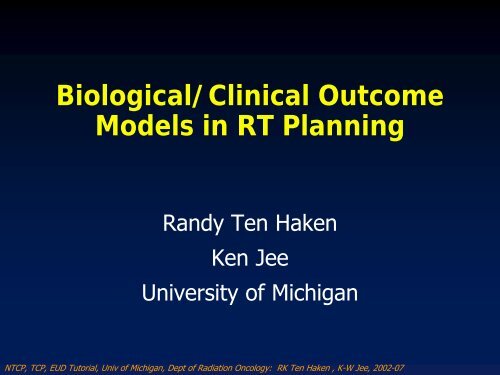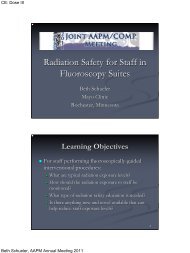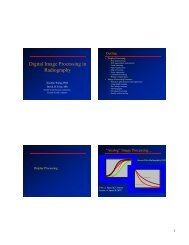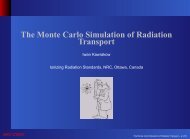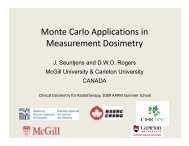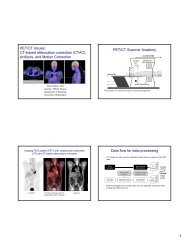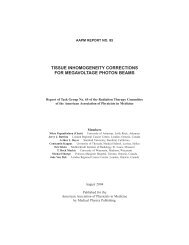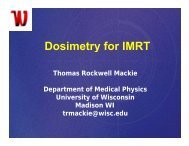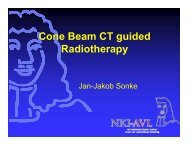Biological/Clinical Outcome Models in RT Planning
Biological/Clinical Outcome Models in RT Planning
Biological/Clinical Outcome Models in RT Planning
Create successful ePaper yourself
Turn your PDF publications into a flip-book with our unique Google optimized e-Paper software.
<strong>Biological</strong>/<strong>Cl<strong>in</strong>ical</strong> <strong>Outcome</strong><br />
<strong>Models</strong> <strong>in</strong> <strong>RT</strong> Plann<strong>in</strong>g<br />
Randy Ten Haken<br />
Ken Jee<br />
University of Michigan<br />
NTCP, TCP, EUD Tutorial, Univ of Michigan, Dept of Radiation Oncology: RK Ten Haken , K-W Jee, 2002-07
Why consider use of models?<br />
• Are there problems that use of<br />
outcomes models could help resolve?<br />
• Would their use make th<strong>in</strong>gs easier or<br />
more consistent?<br />
• Is this relevant today?<br />
NTCP, TCP, EUD Tutorial, Univ of Michigan, Dept of Radiation Oncology: RK Ten Haken , K-W Jee, 2002-07
3D C<strong>RT</strong> – PTV covered!<br />
Volume (%)<br />
100<br />
50<br />
0<br />
0<br />
Target dose must be<br />
uniform to +/- 5%<br />
Dose (%)<br />
-5% + 5%<br />
Desired<br />
NTCP, TCP, EUD Tutorial, Univ of Michigan, Dept of Radiation Oncology: RK Ten Haken , K-W Jee, 2002-07
<strong>RT</strong>OG IM<strong>RT</strong> target criteria<br />
• The prescription dose is the isodose<br />
which encompasses at least 95% of<br />
the PTV.<br />
• No more than 20% of any PTV will<br />
receive >110% of its prescribed dose.<br />
• No more than 1% of any PTV will<br />
receive
Irregular Target Volume DVHs<br />
% Volume<br />
100<br />
80<br />
60<br />
40<br />
20<br />
0<br />
Modality 1<br />
Modality 2<br />
Modality 3<br />
0 20 40 60 80 100 120 140 160 180 200<br />
% Dose (m<strong>in</strong> PTV dose = 100%)<br />
NTCP, TCP, EUD Tutorial, Univ of Michigan, Dept of Radiation Oncology: RK Ten Haken , K-W Jee, 2002-07
Dose normalized to 95% of PTV<br />
% Volume<br />
100<br />
80<br />
60<br />
40<br />
20<br />
0<br />
Plan 1<br />
Plan 2<br />
Plan 3<br />
50 60 70 80 90 100 110 120<br />
% Dose<br />
NTCP, TCP, EUD Tutorial, Univ of Michigan, Dept of Radiation Oncology: RK Ten Haken , K-W Jee, 2002-07
Dose normalized to 95% of PTV<br />
% Volume<br />
100<br />
95<br />
90<br />
85<br />
Plan 1<br />
Plan 2<br />
Plan 3<br />
50 60 70 80 90 100<br />
% Dose<br />
NTCP, TCP, EUD Tutorial, Univ of Michigan, Dept of Radiation Oncology: RK Ten Haken , K-W Jee, 2002-07
Target volume issues<br />
• Are target volume hot spots beneficial?<br />
• Are target volume cold spots<br />
detrimental?<br />
• How do cold spots and hot spots play<br />
off aga<strong>in</strong>st each other?<br />
• Use of TCP or EUD models could<br />
help us make rational decisions<br />
NTCP, TCP, EUD Tutorial, Univ of Michigan, Dept of Radiation Oncology: RK Ten Haken , K-W Jee, 2002-07
Volume (%)<br />
DVH Comparison - normal tissue<br />
100<br />
80<br />
60<br />
40<br />
20<br />
Plan 1<br />
Plan 2<br />
0<br />
0 10 20 30 40 50 60 70 80<br />
Dose (Gy)<br />
Easy!<br />
Plan 2 is less toxic<br />
Volume (%)<br />
0<br />
0 10 20 30 40 50 60 70 80<br />
NTCP, TCP, EUD Tutorial, Univ of Michigan, Dept of Radiation Oncology: RK Ten Haken , K-W Jee, 2002-07<br />
100<br />
80<br />
60<br />
40<br />
20<br />
Plan 1<br />
Plan 2<br />
Dose (Gy)<br />
Who knows?<br />
Depends on tissue type
<strong>RT</strong>OG normal tissue dose criteria<br />
• Small bowel < 30% to receive ≥ 40 Gy<br />
+ m<strong>in</strong>or deviation 30% to 40 Gy<br />
• Rectum < 60% to receive ≥ 30 Gy<br />
+ m<strong>in</strong>or deviation 35% to 50 Gy<br />
• Bladder < 35% to receive ≥ 45 Gy<br />
+ m<strong>in</strong>or deviation 35% to 50 Gy<br />
• Femoral head ≤ 15% to receive ≥ 30 Gy<br />
+ m<strong>in</strong>or deviation 20% to 30 Gy<br />
NTCP, TCP, EUD Tutorial, Univ of Michigan, Dept of Radiation Oncology: RK Ten Haken , K-W Jee, 2002-07
Normal Tissue (Max Dose Constra<strong>in</strong>t)<br />
% Volume<br />
100<br />
80<br />
60<br />
40<br />
20<br />
0<br />
0 10 20 30 40 50 60<br />
Dose (Gy)<br />
Sp<strong>in</strong>al Cord<br />
NTCP, TCP, EUD Tutorial, Univ of Michigan, Dept of Radiation Oncology: RK Ten Haken , K-W Jee, 2002-07
Normal Tissue (S<strong>in</strong>gle Po<strong>in</strong>t Constra<strong>in</strong>t)<br />
% Volume<br />
100<br />
80<br />
60<br />
40<br />
20<br />
0<br />
0 10 20 30 40 50 60<br />
Dose (Gy)<br />
Normal Tissue<br />
NTCP, TCP, EUD Tutorial, Univ of Michigan, Dept of Radiation Oncology: RK Ten Haken , K-W Jee, 2002-07
Normal Tissue (S<strong>in</strong>gle Po<strong>in</strong>t Constra<strong>in</strong>t)<br />
% Volume<br />
100<br />
80<br />
60<br />
40<br />
20<br />
0<br />
Plan 1<br />
Plan 2<br />
Plan 3<br />
0 10 20 30 40 50 60 70 80<br />
Dose (Gy)<br />
NTCP, TCP, EUD Tutorial, Univ of Michigan, Dept of Radiation Oncology: RK Ten Haken , K-W Jee, 2002-07
Normal tissue issues<br />
• The applicability of dose/volume<br />
criteria alone is dependent on:<br />
+ Tissue type<br />
+ Standardization of technique<br />
• Use of models could assimilate effects<br />
of irregular dose distribution across<br />
the entire normal tissue/organ under<br />
consideration.<br />
NTCP, TCP, EUD Tutorial, Univ of Michigan, Dept of Radiation Oncology: RK Ten Haken , K-W Jee, 2002-07
Overall Plan Evaluation<br />
• Optimization of IM<strong>RT</strong> is an <strong>in</strong>herently<br />
multicriteria problem as it <strong>in</strong>volves<br />
multiple plann<strong>in</strong>g goals for target<br />
volumes and their neighbor<strong>in</strong>g critical<br />
tissue structures.<br />
• Successful achievement of one<br />
plann<strong>in</strong>g goal often competes<br />
with those of other plann<strong>in</strong>g<br />
goals.<br />
NTCP, TCP, EUD Tutorial, Univ of Michigan, Dept of Radiation Oncology: RK Ten Haken , K-W Jee, 2002-07
Overall plan evaluation?<br />
Volume (%)<br />
100<br />
75<br />
50<br />
25<br />
0<br />
Target Plan 1<br />
Target Plan 2<br />
Normal Plan 1<br />
Normal Plan 2<br />
0 25 50 75 100<br />
Dose (% of prescription)<br />
NTCP, TCP, EUD Tutorial, Univ of Michigan, Dept of Radiation Oncology: RK Ten Haken , K-W Jee, 2002-07
<strong>Models</strong> could make th<strong>in</strong>gs easier<br />
• Thanks to the prevalence of 3D C<strong>RT</strong>,<br />
considerable data exist relat<strong>in</strong>g tumor<br />
and normal tissue outcomes with<br />
planned dose distributions.<br />
• From the purely technical perspective,<br />
such <strong>in</strong>formation could supplement or<br />
replace simple dose-volume criteria for<br />
<strong>in</strong>verse plann<strong>in</strong>g and/or treatment plan<br />
evaluation.<br />
NTCP, TCP, EUD Tutorial, Univ of Michigan, Dept of Radiation Oncology: RK Ten Haken , K-W Jee, 2002-07
Outl<strong>in</strong>e<br />
• Normal Tissue Complication<br />
Probability (NTCP) models<br />
• Tumor Control Probability (TCP)<br />
models<br />
• Equivalent Uniform Dose (EUD) for<br />
tumors and normal tissues<br />
• <strong>Cl<strong>in</strong>ical</strong> Response Model<strong>in</strong>g<br />
+ Maximum likelihood analysis<br />
+ Confound<strong>in</strong>g variables and problems<br />
NTCP, TCP, EUD Tutorial, Univ of Michigan, Dept of Radiation Oncology: RK Ten Haken , K-W Jee, 2002-07
Why use an NTCP model?<br />
• We would like to be able to fully describe<br />
complications as a function of any dose to<br />
any volume.<br />
• Most cl<strong>in</strong>ical trials will only sample the low<br />
portion of any normal tissue complication<br />
probability (NTCP) frequency distribution.<br />
• Start with a model based on normal<br />
statistical distributions<br />
+ Try to parameterize the model for future use<br />
us<strong>in</strong>g a limited amount of <strong>in</strong>formation<br />
NTCP, TCP, EUD Tutorial, Univ of Michigan, Dept of Radiation Oncology: RK Ten Haken , K-W Jee, 2002-07
The Lyman NTCP Model<br />
Lyman JT: Complication probability – as assessed from dosevolume<br />
histograms. Radiat Res 104:S13-S19, 1985.<br />
NTCP, TCP, EUD Tutorial, Univ of Michigan, Dept of Radiation Oncology: RK Ten Haken , K-W Jee, 2002-07
The Lyman NTCP Model<br />
• The Lyman NTCP model attempts to<br />
mathematically describe complications<br />
associated with uniform partial organ<br />
irradiation.<br />
• This implies:<br />
+ A fractional volume, V, of the organ<br />
receives a s<strong>in</strong>gle uniform dose, D.<br />
+ The rest of the organ, (1 – V ), receives<br />
zero dose.<br />
+ i.e., a s<strong>in</strong>gle step DVH, {D , V }<br />
NTCP, TCP, EUD Tutorial, Univ of Michigan, Dept of Radiation Oncology: RK Ten Haken , K-W Jee, 2002-07
NTCP vs Dose for a fixed volume<br />
For each uniformly irradiated<br />
fractional volume (v i ), the<br />
Lyman model assumes that the<br />
distribution of complications as<br />
a function of Dose (D ) can be<br />
described by a normal<br />
distribution<br />
+ with mean TD 50 (v i )<br />
+ standard deviation m • TD 50 (v i )<br />
NTCP, TCP, EUD Tutorial, Univ of Michigan, Dept of Radiation Oncology: RK Ten Haken , K-W Jee, 2002-07<br />
Fractional Volume (v )<br />
Fraction of Complication seen<br />
1.0<br />
0.8<br />
0.6<br />
0.4<br />
0.2<br />
0.0<br />
0<br />
0.09<br />
0.08<br />
0.07<br />
0.06<br />
0.05<br />
0.04<br />
0.03<br />
0.02<br />
0.01<br />
0<br />
20<br />
40<br />
60<br />
Dose (Gy)<br />
80<br />
40 60 80<br />
Dose (Gy)<br />
100
NTCP vs Dose for a fixed volume<br />
The NTCP as a function<br />
of dose, D , to that<br />
uniformly irradiated<br />
volume, v i , can then be<br />
described by the <strong>in</strong>tegral<br />
probability:<br />
NTCP = (2π) -1/2 -∞ ∫ t<br />
exp(-x 2 /2) dx<br />
where;<br />
t = (D - TD 50 (v i )) / (m • TD 50 (v i ))<br />
NTCP, TCP, EUD Tutorial, Univ of Michigan, Dept of Radiation Oncology: RK Ten Haken , K-W Jee, 2002-07<br />
NTCP (%)<br />
100<br />
80<br />
60<br />
40<br />
20<br />
0<br />
0<br />
20<br />
40<br />
60<br />
80<br />
Dose (Gy)<br />
100<br />
120<br />
140
NTCP vs Dose for a different volume<br />
Similarly for a different<br />
uniformly irradiated<br />
fractional volume (v j ):<br />
NTCP = (2π) -1/2 -∞ ∫ t<br />
exp(-x 2 /2) dx<br />
where;<br />
t = (D - TD 50 (v j )) / (m • TD 50 (v j ))<br />
NTCP, TCP, EUD Tutorial, Univ of Michigan, Dept of Radiation Oncology: RK Ten Haken , K-W Jee, 2002-07<br />
Fractional Volume (v )<br />
NTCP (%)<br />
1.0<br />
0.8<br />
0.6<br />
0.4<br />
0.2<br />
0.0<br />
0<br />
100<br />
80<br />
60<br />
40<br />
20<br />
0<br />
0<br />
20<br />
20<br />
40<br />
40<br />
60<br />
Dose (Gy)<br />
60<br />
80<br />
Dose (Gy)<br />
80<br />
100<br />
120<br />
100<br />
140
Lyman NTCP description<br />
The f<strong>in</strong>al step:<br />
+ assume that the mean dose, TD 50 (v ), for<br />
the distribution of complications for each<br />
uniformly irradiated fractional volume v ,<br />
+ is related to the mean dose for the<br />
distribution of complications for uniform<br />
irradiation of the whole organ volume,<br />
TD 50 (1),<br />
+ through a power law “volume effect”<br />
relationship:<br />
TD 50(v ) = TD 50(1) • v -n<br />
NTCP, TCP, EUD Tutorial, Univ of Michigan, Dept of Radiation Oncology: RK Ten Haken , K-W Jee, 2002-07
The Lyman NTCP Description<br />
NTCP = (2π) -1/2 -∞ ∫ t<br />
where;<br />
and;<br />
exp(-x 2 / 2) dx,<br />
t = (D - TD 50 (v )) / (m • TD 50 (v )),<br />
TD 50 (v ) = TD 50 (1) • v -n<br />
Lyman JT: Complication probability – as assessed from dosevolume<br />
histograms. Radiat Res 104:S13-S19, 1985.<br />
NTCP, TCP, EUD Tutorial, Univ of Michigan, Dept of Radiation Oncology: RK Ten Haken , K-W Jee, 2002-07
Lyman Model dose-volume-response surface<br />
Volume<br />
Dose<br />
Response<br />
NTCP, TCP, EUD Tutorial, Univ of Michigan, Dept of Radiation Oncology: RK Ten Haken , K-W Jee, 2002-07
with a large volume effect (n = 0.80, m = 0.15, TD 50 = 35 Gy)<br />
100<br />
80<br />
60<br />
40<br />
NTCP Dose-volume-response contours for a tissue<br />
20<br />
0<br />
0<br />
20<br />
40<br />
60<br />
80<br />
100<br />
Dose (Gy)<br />
120<br />
V = 1.0<br />
V = .75<br />
V = .50<br />
V = .25<br />
140<br />
Fractional Volume<br />
0.0<br />
0<br />
NTCP, TCP, EUD Tutorial, Univ of Michigan, Dept of Radiation Oncology: RK Ten Haken , K-W Jee, 2002-07<br />
1.0<br />
0.8<br />
0.6<br />
0.4<br />
0.2<br />
20<br />
40<br />
60<br />
80<br />
100<br />
Dose (Gy)<br />
120<br />
1%<br />
5%<br />
20%<br />
50%<br />
80%<br />
95%<br />
99%<br />
140
Volume Effect (partial volume contours)<br />
NTCP, TCP, EUD Tutorial, Univ of Michigan, Dept of Radiation Oncology: RK Ten Haken , K-W Jee, 2002-07
Volume Effect (partial volume contours)<br />
NTCP, TCP, EUD Tutorial, Univ of Michigan, Dept of Radiation Oncology: RK Ten Haken , K-W Jee, 2002-07
Volume Effect (Iso-NTCP contours)<br />
NTCP, TCP, EUD Tutorial, Univ of Michigan, Dept of Radiation Oncology: RK Ten Haken , K-W Jee, 2002-07
Volume Effect (Iso-NTCP contours)<br />
NTCP, TCP, EUD Tutorial, Univ of Michigan, Dept of Radiation Oncology: RK Ten Haken , K-W Jee, 2002-07
Us<strong>in</strong>g the Lyman NTCP description<br />
• The Lyman NTCP description attempts<br />
to describe uniform partial organ<br />
irradiation.<br />
• This implies:<br />
+ A fractional volume, V, of the organ<br />
receives a s<strong>in</strong>gle uniform dose, D.<br />
+ The rest of the organ, (1 - V), receives<br />
zero dose.<br />
+ i.e., a s<strong>in</strong>gle step DVH, {D , V}<br />
NTCP, TCP, EUD Tutorial, Univ of Michigan, Dept of Radiation Oncology: RK Ten Haken , K-W Jee, 2002-07
DVH reduction schemes<br />
• For non-uniform irradiation, the 3D dose<br />
volume distribution (or DVH) must be<br />
reduced to a s<strong>in</strong>gle step DVH that could be<br />
expected to produce an identical NTCP.<br />
+ Wolbarst & Lyman schemes reduce DVHs to<br />
uniform irradiation of entire organ (V=1) to<br />
some reduced effective dose, D eff .<br />
+ Kutcher & Burman scheme reduces a DVH to<br />
uniform irradiation of an effective fraction of<br />
the organ, V eff , to some reference dose, D ref .<br />
NTCP, TCP, EUD Tutorial, Univ of Michigan, Dept of Radiation Oncology: RK Ten Haken , K-W Jee, 2002-07
Effective Volume DVH reduction scheme<br />
V eff = Σ { v i • (D i / D ref) 1/n }<br />
Partial<br />
Volume<br />
D i<br />
ΔV i<br />
D ref<br />
} ΔVeff Dose<br />
Partial<br />
Volume<br />
V eff<br />
Dose<br />
NTCP, TCP, EUD Tutorial, Univ of Michigan, Dept of Radiation Oncology: RK Ten Haken , K-W Jee, 2002-07<br />
D ref
S<strong>in</strong>gle step {D ref , V eff } DVHs<br />
100<br />
75<br />
50<br />
25<br />
0<br />
Direct DVH<br />
V eff<br />
D ref<br />
0 20 40 60 80 100<br />
Dose (Gy)<br />
100<br />
NTCP, TCP, EUD Tutorial, Univ of Michigan, Dept of Radiation Oncology: RK Ten Haken , K-W Jee, 2002-07<br />
75<br />
50<br />
25<br />
0<br />
Cumulative DVH<br />
V eff<br />
Dref 0 20 40 60 80 100<br />
Dose (Gy)
V eff DVH reduction → NTCP evaluation<br />
100<br />
75<br />
50<br />
Cumulative DVH<br />
V eff<br />
25<br />
0<br />
Dref 0 20 40 60 80 100<br />
Dose (Gy)<br />
Fractional Volume<br />
NTCP, TCP, EUD Tutorial, Univ of Michigan, Dept of Radiation Oncology: RK Ten Haken , K-W Jee, 2002-07<br />
1.0<br />
0.8<br />
0.6<br />
0.4<br />
0.2<br />
0.0<br />
0<br />
V eff<br />
20<br />
40<br />
60<br />
D ref<br />
80<br />
100<br />
Dose (Gy)<br />
120<br />
1%<br />
5%<br />
20%<br />
50%<br />
80%<br />
95%<br />
99%<br />
140
Local Radiation Response -<br />
Organ Functional Reserve <strong>Models</strong><br />
• Offer the potential for a more direct<br />
visualization of the relationship between<br />
the DVH and radiation damage<br />
• May (ultimately) offer the possibility of<br />
l<strong>in</strong>k<strong>in</strong>g cellular and organ subunit<br />
radiobiology to the prediction of radiation<br />
complications.<br />
NTCP, TCP, EUD Tutorial, Univ of Michigan, Dept of Radiation Oncology: RK Ten Haken , K-W Jee, 2002-07
Local Radiation Response -<br />
Organ Functional Reserve <strong>Models</strong><br />
• Jackson A, Kutcher GJ, Yorke E. Med<br />
Phys 20:613-525, 1993.<br />
• Niemierko A, Goite<strong>in</strong> M. Int J Radiat<br />
Oncol Biol Phys 25:135-145, 1993.<br />
NTCP, TCP, EUD Tutorial, Univ of Michigan, Dept of Radiation Oncology: RK Ten Haken , K-W Jee, 2002-07
Local Damage Function<br />
Fraction (f) of a macroscopic volume<br />
element <strong>in</strong>capacitated by a dose D can be<br />
described by a simple response function:<br />
1<br />
f = ––––––––––––––<br />
( 1 + (D 50 / D) k )<br />
where D 50 is the dose which <strong>in</strong>capacitates<br />
half the volume and “k” describes the<br />
steepness of the “local damage” function.<br />
NTCP, TCP, EUD Tutorial, Univ of Michigan, Dept of Radiation Oncology: RK Ten Haken , K-W Jee, 2002-07
Local Damage Function<br />
Volume ( %)<br />
100<br />
75<br />
50<br />
25<br />
0<br />
100<br />
NTCP, TCP, EUD Tutorial, Univ of Michigan, Dept of Radiation Oncology: RK Ten Haken , K-W Jee, 2002-07<br />
1<br />
0 1 2 3 4 5 6 7 8 9<br />
7<br />
Dose (Gy)<br />
25<br />
37<br />
75<br />
50<br />
25<br />
0<br />
Fx Incapacitated
Total Estimated Damage<br />
Total fraction (F ) of the organ that<br />
is <strong>in</strong>capacitated is equal to the sum<br />
of the fractions of the <strong>in</strong>dividual<br />
macroscopic volume elements<br />
destroyed.<br />
F = Σ f i<br />
NTCP, TCP, EUD Tutorial, Univ of Michigan, Dept of Radiation Oncology: RK Ten Haken , K-W Jee, 2002-07
Organ Injury Function<br />
NTCP = (2π) -1/2 -∞<br />
where<br />
F 50 is the fraction of the total organ damaged<br />
which would produce a 50% complication<br />
rate,<br />
σ ν describes the steepness of the “organ”<br />
response function<br />
NTCP, TCP, EUD Tutorial, Univ of Michigan, Dept of Radiation Oncology: RK Ten Haken , K-W Jee, 2002-07<br />
∫ t<br />
t = (F - F 50 ) / σ ν<br />
exp (-x 2 / 2) dx,
Organ Injury Function<br />
NTCP (%)<br />
100<br />
90<br />
80<br />
70<br />
60<br />
50<br />
40<br />
30<br />
20<br />
10<br />
0<br />
Cumulative Functional Reserve<br />
(F50 = 0.40; σ = 0.077)<br />
0 10 20 30 40 50 60 70 80 90 100<br />
Fraction Damaged (%)<br />
NTCP, TCP, EUD Tutorial, Univ of Michigan, Dept of Radiation Oncology: RK Ten Haken , K-W Jee, 2002-07
Tumor Control Probability (TCP)<br />
Calculations<br />
NTCP, TCP, EUD Tutorial, Univ of Michigan, Dept of Radiation Oncology: RK Ten Haken , K-W Jee, 2002-07
TCP Calculation Assumptions<br />
• An <strong>in</strong>homogeneously irradiated tumor<br />
volume is composed of smaller volume<br />
elements,<br />
+ each with uniform dose,<br />
+ each respond<strong>in</strong>g <strong>in</strong>dependently to<br />
radiation.<br />
NTCP, TCP, EUD Tutorial, Univ of Michigan, Dept of Radiation Oncology: RK Ten Haken , K-W Jee, 2002-07
Basic TCP <strong>Models</strong><br />
• “Tumorlet” model (Goite<strong>in</strong>, Brahme...<br />
• Survival of clonogenic cells (Webb,<br />
Nahum, ...<br />
NTCP, TCP, EUD Tutorial, Univ of Michigan, Dept of Radiation Oncology: RK Ten Haken , K-W Jee, 2002-07
“Tumorlet” TCP Model<br />
• Tumorlet radiosensitivity estimated<br />
from the dose-response assumed for<br />
the entire tumor.<br />
• Overall TCP predicted by product of<br />
the TCPs for each tumorlet.<br />
NTCP, TCP, EUD Tutorial, Univ of Michigan, Dept of Radiation Oncology: RK Ten Haken , K-W Jee, 2002-07
“Tumorlet” TCP Assumptions<br />
TCP of uniformly irradiated “tumorlet” with partial<br />
fractional volume V i is estimated from the dose<br />
response assumed for uniform irradiation of the<br />
entire tumor to the same dose D i :<br />
us<strong>in</strong>g:<br />
TCP ( D i ,1) = 1 / {1 + ( D 50 / D i ) k }<br />
TCP ( D i ,V i ) = [TCP ( D i ,1)] Vi<br />
NTCP, TCP, EUD Tutorial, Univ of Michigan, Dept of Radiation Oncology: RK Ten Haken , K-W Jee, 2002-07
Tumorlet TCPs<br />
Volume ( %)<br />
100<br />
75<br />
50<br />
25<br />
0<br />
100<br />
NTCP, TCP, EUD Tutorial, Univ of Michigan, Dept of Radiation Oncology: RK Ten Haken , K-W Jee, 2002-07<br />
10<br />
50<br />
80<br />
0 1 2 3 4 5 6 7 8 9<br />
Dose (Gy)<br />
100<br />
75<br />
50<br />
25<br />
0<br />
TCP (%)
“Tumorlet” TCP Assumptions<br />
Overall TCP predicted by product of<br />
the TCPs for each tumorlet.<br />
TCP total = Π i TCP ( D i ,V i )<br />
NTCP, TCP, EUD Tutorial, Univ of Michigan, Dept of Radiation Oncology: RK Ten Haken , K-W Jee, 2002-07
Clonogenic Cells TCP Model<br />
• Number of surviv<strong>in</strong>g clonogenic cells<br />
estimated for each dose level and<br />
summed to obta<strong>in</strong> total number of<br />
surviv<strong>in</strong>g cells<br />
• Overall TCP related to total number of<br />
surviv<strong>in</strong>g clonogenic cells<br />
NTCP, TCP, EUD Tutorial, Univ of Michigan, Dept of Radiation Oncology: RK Ten Haken , K-W Jee, 2002-07
Surviv<strong>in</strong>g Clonogenic Cells TCP<br />
Calculation<br />
For uniform <strong>in</strong>itial clonogenic cell density ρ,<br />
and uniform radiosensitivity α, the number<br />
of surviv<strong>in</strong>g clonogenic cells for each b<strong>in</strong> of<br />
the DVH {V j (cm 3 ), D j (Gy)} is estimated as:<br />
N s, j = ρV j exp (- α D j)<br />
NTCP, TCP, EUD Tutorial, Univ of Michigan, Dept of Radiation Oncology: RK Ten Haken , K-W Jee, 2002-07
Surviv<strong>in</strong>g Clonogenic Cells TCP<br />
Calculation<br />
The total number of surviv<strong>in</strong>g clonogenic<br />
cells is then the sum over all b<strong>in</strong>s of the<br />
DVH:<br />
N s, tot = Σ j ρ V j exp (- α D j),<br />
from which the TCP is estimated:<br />
TCP = exp (- N s, tot )<br />
NTCP, TCP, EUD Tutorial, Univ of Michigan, Dept of Radiation Oncology: RK Ten Haken , K-W Jee, 2002-07
Equivalent Uniform Dose<br />
• Uniform dose distribution that if<br />
delivered over the same number of<br />
fractions would yield the same<br />
radiobiological or cl<strong>in</strong>ical effect.<br />
+ Niemierko 1996<br />
+ Brahme 1991<br />
+ Niemierko 1999 (abstract) gEUD<br />
NTCP, TCP, EUD Tutorial, Univ of Michigan, Dept of Radiation Oncology: RK Ten Haken , K-W Jee, 2002-07
Equivalent Uniform Dose for Target Volume<br />
EUD = 2 • ln { Σ v i (SF 2 ) Di/2 } / ln (SF 2 )<br />
SF 2 = Fx of clonogens surviv<strong>in</strong>g<br />
s<strong>in</strong>gle 2 Gy dose<br />
v i<br />
= fractional volume<br />
D i = uniform dose to v i<br />
Volume<br />
NTCP, TCP, EUD Tutorial, Univ of Michigan, Dept of Radiation Oncology: RK Ten Haken , K-W Jee, 2002-07<br />
Dose
Generalized Equivalent Uniform Dose (gEUD)<br />
ROI with N dose po<strong>in</strong>ts d i<br />
gEUD<br />
⎛<br />
⎜<br />
⎜<br />
⎜<br />
⎜<br />
NTCP, TCP, EUD Tutorial, Univ of Michigan, Dept of Radiation Oncology: RK Ten Haken , K-W Jee, 2002-07<br />
Volume<br />
Volume (cc)<br />
25<br />
20<br />
15<br />
10<br />
5<br />
0<br />
1 2 3 4 5 6 7 8 9 10 11 12 13 14 15 16 17<br />
Dose (Gy)<br />
Dose (Gy)<br />
1 / a<br />
N<br />
∑<br />
a<br />
d i<br />
1 / a<br />
⎛<br />
i<br />
a ⎞<br />
= 1 ≡ ⎜ v d ⎟ i i<br />
N ⎝ i ⎠<br />
⎞<br />
⎟<br />
⎟<br />
⎟<br />
⎟<br />
≡ ∑<br />
DVH (fractional volume v i receives dose d i )
gEUD<br />
gEUD<br />
⎛<br />
⎜<br />
⎜<br />
⎜<br />
⎜<br />
⎝<br />
1 / a<br />
N<br />
∑<br />
a<br />
d i<br />
1 / a<br />
⎛<br />
i<br />
a ⎞<br />
= 1 ≡ ⎜ v d ⎟ i i<br />
N ⎝ i ⎠<br />
NTCP, TCP, EUD Tutorial, Univ of Michigan, Dept of Radiation Oncology: RK Ten Haken , K-W Jee, 2002-07<br />
⎞<br />
⎟<br />
⎟<br />
⎟<br />
⎟<br />
⎠<br />
≡ ∑<br />
Tumors: a is a negative number<br />
Normal Tissues: a is a positive number<br />
For a = 1, gEUD = mean dose<br />
For a = 2, gEUD = rms dose<br />
For a = - ∞, gEUD = m<strong>in</strong>imum dose<br />
For a = +∞, gEUD = maximum dose<br />
(discont<strong>in</strong>uous at a = 0)
Volume (%)<br />
25<br />
20<br />
15<br />
10<br />
⎛ a ⎞<br />
gEUD ≡ ⎜∑v<br />
id i ⎟<br />
⎝ i ⎠<br />
5<br />
0<br />
1 2 3 4 5 6 7 40 8 45 9 10 50 11 55 12 60 13 65 14 70 15 75 16 17<br />
Dose (Gy)<br />
1 / a<br />
Tumors: a is negative<br />
aggressive a = -20<br />
non a = -5<br />
Normal Tissues: a is positive<br />
LKB Model a = 1/n<br />
For a = 1, gEUD = mean dose<br />
For a = 2, gEUD = rms dose<br />
For a = - ∞, gEUD = m<strong>in</strong>imum dose<br />
For a = + ∞, gEUD = maximum dose<br />
(discont<strong>in</strong>uous at a = 0)<br />
NTCP, TCP, EUD Tutorial, Univ of Michigan, Dept of Radiation Oncology: RK Ten Haken , K-W Jee, 2002-07<br />
gEUD (Gy)<br />
80<br />
75<br />
70<br />
65<br />
60<br />
55<br />
50<br />
45<br />
40<br />
35<br />
30<br />
-100 -80 -60 -40 -20 0 20 40 60 80 100<br />
"a"
EUD NTCP description<br />
For uniform irradiation of<br />
the whole organ, assumes<br />
that the distribution of<br />
complications as a function<br />
of dose can be described<br />
by a normal distribution<br />
+ with mean TD 50<br />
+ standard deviation m •TD 50<br />
40 60<br />
Dose (Gy)<br />
NTCP, TCP, EUD Tutorial, Univ of Michigan, Dept of Radiation Oncology: RK Ten Haken , K-W Jee, 2002-07<br />
Volume<br />
Fraction of Complication seen<br />
1.0<br />
0.8<br />
0.6<br />
0.4<br />
0.2<br />
0.0<br />
0<br />
0.09<br />
0.08<br />
0.07<br />
0.06<br />
0.05<br />
0.04<br />
0.03<br />
0.02<br />
0.01<br />
0<br />
20<br />
80<br />
40 60 80<br />
Dose (Gy)<br />
100
The EUD NTCP description<br />
The NTCP as a function<br />
of uniform dose, EUD , to<br />
the whole volume can<br />
then be described by the<br />
<strong>in</strong>tegral probability:<br />
NTCP = (2π) -1/2 -∞ ∫ t<br />
exp(-x 2 /2) dx<br />
where;<br />
t = (EUD - EUD 50) / (m • EUD 50)<br />
NTCP, TCP, EUD Tutorial, Univ of Michigan, Dept of Radiation Oncology: RK Ten Haken , K-W Jee, 2002-07<br />
NTCP (%)<br />
100<br />
80<br />
60<br />
40<br />
20<br />
0<br />
0<br />
20<br />
40<br />
60<br />
80<br />
Dose (Gy)<br />
100<br />
120<br />
140
Local response function<br />
• Required to change non-uniformly irradiated<br />
volume to equivalent uniform dose EUD<br />
• gEUD is one very general form of this<br />
function (their can be many others):<br />
+ Seppenwoolde Y, Lebesque JV, de Jaeger K,<br />
Belderbos JS, Boersma LJ, Schilstra C, Henn<strong>in</strong>g<br />
GT, Hayman JA, Martel MK, Ten Haken RK:<br />
Compar<strong>in</strong>g different NTCP models that predict<br />
the <strong>in</strong>cidence of radiation pneumonitis. Int J<br />
Radiat Oncol Biol Phys 55:724-735, 2003.<br />
NTCP, TCP, EUD Tutorial, Univ of Michigan, Dept of Radiation Oncology: RK Ten Haken , K-W Jee, 2002-07
2 parameters<br />
EUD=MLD<br />
NTCP =<br />
t<br />
=<br />
1<br />
2π<br />
t − x<br />
2<br />
∫ e<br />
−∞<br />
EUD − EUD<br />
m ⋅ EUD<br />
2<br />
dx<br />
50<br />
3 parameters<br />
n = 1 D50 = ∞<br />
EUDLKB NTCP<br />
n<br />
EUD 50 , m<br />
EUD model<br />
4 parameters<br />
D 50 , k<br />
EUD Logistic<br />
rdV<br />
m ⋅ rdV<br />
rdV= F D<br />
rdV<br />
50<br />
50<br />
NTCP, TCP, EUD Tutorial, Univ of Michigan, Dept of Radiation Oncology: RK Ten Haken , K-W Jee, 2002-07<br />
t<br />
=<br />
NTCP =<br />
1<br />
2π<br />
−<br />
2<br />
t − x<br />
2<br />
∫ e<br />
−∞<br />
NTCP<br />
50<br />
dx<br />
V Dth50 , m<br />
3 parameters<br />
k = ∞<br />
V Dth<br />
V Dth<br />
V Dth
cast of thousands here...<br />
would you believe 100’s??<br />
...maybe tens?<br />
NTCP/TCP model<strong>in</strong>g<br />
We’ve come a long way.....<br />
But.......<br />
OK, beware! mostly<br />
personal op<strong>in</strong>ion<br />
may follow<br />
NTCP, TCP, EUD Tutorial, Univ of Michigan, Dept of Radiation Oncology: RK Ten Haken , K-W Jee, 2002-07
Conceptually Simple<br />
• Pick a Model<br />
• Look at some Patients<br />
+ Have 3-D Dose Distributions<br />
+ Have 3-D Volumes<br />
+ Have <strong>Outcome</strong>s<br />
• Use patient data to parameterize<br />
and/or test model<br />
NTCP, TCP, EUD Tutorial, Univ of Michigan, Dept of Radiation Oncology: RK Ten Haken , K-W Jee, 2002-07
¿No Problemo?<br />
3-D<br />
DVH<br />
Functional<br />
Reserve<br />
Veff<br />
NTCP<br />
NTCP, TCP, EUD Tutorial, Univ of Michigan, Dept of Radiation Oncology: RK Ten Haken , K-W Jee, 2002-07
Well........<br />
NTCP, TCP, EUD Tutorial, Univ of Michigan, Dept of Radiation Oncology: RK Ten Haken , K-W Jee, 2002-07
The <strong>Models</strong><br />
Biologists and Physicists and Physicians<br />
Agree the <strong>Models</strong> are:<br />
Too simple or naive (papa bear)<br />
+ Biology is more complex than this<br />
+ Not enough parameters<br />
Too complex (mama bear)<br />
+ Too many parameters<br />
+ Is this still biology?<br />
Still look<strong>in</strong>g for baby bear’s model<br />
NTCP, TCP, EUD Tutorial, Univ of Michigan, Dept of Radiation Oncology: RK Ten Haken , K-W Jee, 2002-07
Model<strong>in</strong>g<br />
• Model vs. Theory<br />
+ <strong>Models</strong> <strong>in</strong>terpolate<br />
+ Theories extrapolate<br />
• Mathematics vs. Biology<br />
+ K.I.S.S.<br />
NTCP, TCP, EUD Tutorial, Univ of Michigan, Dept of Radiation Oncology: RK Ten Haken , K-W Jee, 2002-07
<strong>Models</strong>?<br />
• Probably best to say that at this po<strong>in</strong>t<br />
much of this is still phenomenological<br />
and “descriptive” rather than<br />
predictive.<br />
NTCP, TCP, EUD Tutorial, Univ of Michigan, Dept of Radiation Oncology: RK Ten Haken , K-W Jee, 2002-07
Model Fitt<strong>in</strong>g<br />
• Generally not enough solid data po<strong>in</strong>ts<br />
(complications) to yield quantitative<br />
results<br />
• Large confidence limits on model<br />
parameters<br />
• No effective means of determ<strong>in</strong><strong>in</strong>g<br />
“goodness of fit”<br />
NTCP, TCP, EUD Tutorial, Univ of Michigan, Dept of Radiation Oncology: RK Ten Haken , K-W Jee, 2002-07
Model Fitt<strong>in</strong>g (the good news!)<br />
• We now have collaborations with<br />
genu<strong>in</strong>e bio-statisticians who are<br />
apply<strong>in</strong>g valid statistical methods to<br />
the data analyses and the new<br />
protocol designs.<br />
NTCP, TCP, EUD Tutorial, Univ of Michigan, Dept of Radiation Oncology: RK Ten Haken , K-W Jee, 2002-07
Input Data: Dose<br />
• Calculational algorithms are better<br />
• Can compute 3-D distributions<br />
• Dose distributions are complex<br />
+ Non-uniform<br />
+ Daily variations not easily <strong>in</strong>cluded<br />
NTCP, TCP, EUD Tutorial, Univ of Michigan, Dept of Radiation Oncology: RK Ten Haken , K-W Jee, 2002-07
Input Data: Volume<br />
• 3-D yields Volumes<br />
+ Physical Volume (size and shape)<br />
+ Position<br />
• How accurate are the <strong>in</strong>put data?<br />
+ For first treatment?<br />
+ As a basis for the whole treatment?<br />
NTCP, TCP, EUD Tutorial, Univ of Michigan, Dept of Radiation Oncology: RK Ten Haken , K-W Jee, 2002-07
Input Data: Dose-Volume<br />
• Difficult to track which volume<br />
receives what dose<br />
+ Time factors often ignored<br />
• Changes not easily accommodated<br />
+ Tumor shr<strong>in</strong>kage<br />
+ Inter and Intra treatment changes and<br />
processes<br />
NTCP, TCP, EUD Tutorial, Univ of Michigan, Dept of Radiation Oncology: RK Ten Haken , K-W Jee, 2002-07
Model<strong>in</strong>g Summary<br />
• Careful studies of the partial organ<br />
tolerance of normal tissues to<br />
therapeutic ioniz<strong>in</strong>g radiation are<br />
emerg<strong>in</strong>g, as are attempts to model<br />
these data.<br />
• We should be encouraged by the<br />
progress <strong>in</strong> this area.<br />
NTCP, TCP, EUD Tutorial, Univ of Michigan, Dept of Radiation Oncology: RK Ten Haken , K-W Jee, 2002-07
Model<strong>in</strong>g Summary<br />
• However, the ability to use the NTCP<br />
models themselves reliably, and <strong>in</strong> a<br />
predictive way is still an area of active<br />
research and should be approached<br />
with great caution <strong>in</strong> a cl<strong>in</strong>ical sett<strong>in</strong>g.<br />
NTCP, TCP, EUD Tutorial, Univ of Michigan, Dept of Radiation Oncology: RK Ten Haken , K-W Jee, 2002-07
“All models are wrong,<br />
but some are useful.”<br />
G.E.P. Box, 1979 *<br />
*”Robustness <strong>in</strong> the Strategy of Scientific Model Build<strong>in</strong>g." IN: Robustness <strong>in</strong> Statistics. 201-<br />
236. R. L. Launer and G. N. Wilk<strong>in</strong>son, eds. Academic Press, NY. 1979<br />
NTCP, TCP, EUD Tutorial, Univ of Michigan, Dept of Radiation Oncology: RK Ten Haken , K-W Jee, 2002-07
A cl<strong>in</strong>ical example<br />
• Patients at our <strong>in</strong>stitution with tumors<br />
<strong>in</strong> the liver or lung have been treated<br />
accord<strong>in</strong>g to IRB approved protocols<br />
that seek to escalate homogeneous<br />
dose (+7%, -5%) to the PTV at a<br />
fixed normal liver/lung iso-NTCP.<br />
NTCP, TCP, EUD Tutorial, Univ of Michigan, Dept of Radiation Oncology: RK Ten Haken , K-W Jee, 2002-07
Difficulties <strong>in</strong> implementation<br />
• Frequently the risk to other OARs<br />
(e.g., stomach-duodenum /<br />
esophagus) limits the tumor dose to<br />
below that which could be justified<br />
based solely on liver/lung NTCP,<br />
+ especially when there is an overlap<br />
between the PTV and an external (to<br />
the liver/lung) OAR.<br />
NTCP, TCP, EUD Tutorial, Univ of Michigan, Dept of Radiation Oncology: RK Ten Haken , K-W Jee, 2002-07
Liver tumor PTV-OAR overlap<br />
NTCP, TCP, EUD Tutorial, Univ of Michigan, Dept of Radiation Oncology: RK Ten Haken , K-W Jee, 2002-07
Lung tumor PTV- OAR overlap<br />
NTCP, TCP, EUD Tutorial, Univ of Michigan, Dept of Radiation Oncology: RK Ten Haken , K-W Jee, 2002-07
Can we do better?<br />
• Optimized beamlet IM<strong>RT</strong> may benefit<br />
these patients.<br />
• However, even with IM<strong>RT</strong>, <strong>in</strong> order to<br />
<strong>in</strong>crease the mean PTV dose above<br />
the maximum tolerated dose of one of<br />
these OARs, it is necessary to relax<br />
PTV homogeneity constra<strong>in</strong>ts.<br />
• But, how does one do this <strong>in</strong> a logical<br />
–mean<strong>in</strong>gful way?<br />
NTCP, TCP, EUD Tutorial, Univ of Michigan, Dept of Radiation Oncology: RK Ten Haken , K-W Jee, 2002-07
Use of models <strong>in</strong> optimization<br />
• <strong>Models</strong> for target and normal tissues<br />
could aid <strong>in</strong> plann<strong>in</strong>g, as their use would<br />
<strong>in</strong>tegrate the contribut<strong>in</strong>g effects of all<br />
parts of target and normal tissues dose<br />
distributions.<br />
NTCP, TCP, EUD Tutorial, Univ of Michigan, Dept of Radiation Oncology: RK Ten Haken , K-W Jee, 2002-07
Use of models <strong>in</strong> optimization<br />
• We explored IM<strong>RT</strong> optimization utiliz<strong>in</strong>g:<br />
+ gEUD costlets for the PTVs to<br />
maximize anti-tumor effects,<br />
+ NTCP costlets to ma<strong>in</strong>ta<strong>in</strong> OAR doses<br />
with<strong>in</strong> protocol limits.<br />
Thomas E, Chapet O, Kessler ML, Lawrence TS, Ten Haken RK: The benefit of us<strong>in</strong>g<br />
biological parameters (EUD and NTCP) <strong>in</strong> IM<strong>RT</strong> optimization for the treatment of<br />
<strong>in</strong>trahepatic tumors. Int J Radiat Oncol Biol Phys 62:571-578, 2005.<br />
Chapet O, Thomas E, Kessler ML, Fraass BA, Ten Haken RK: Esophagus spar<strong>in</strong>g with IM<strong>RT</strong><br />
<strong>in</strong> lung tumor irradiation, an EUD-based optimization technique. Int J Radiat Oncol Biol<br />
Phys 63:179-187, 2005.<br />
NTCP, TCP, EUD Tutorial, Univ of Michigan, Dept of Radiation Oncology: RK Ten Haken , K-W Jee, 2002-07
Non-uniform liver PTV irradiation<br />
NTCP, TCP, EUD Tutorial, Univ of Michigan, Dept of Radiation Oncology: RK Ten Haken , K-W Jee, 2002-07
PTV DVHs for liver patient<br />
VOLUME (%)<br />
110<br />
100<br />
90<br />
80<br />
70<br />
60<br />
50<br />
40<br />
30<br />
20<br />
10<br />
0<br />
0 10 20 30 40 50 60 70 80 90 100<br />
DOSE (Gy)<br />
CONFORMAL<br />
IM<strong>RT</strong> ORIG ANG<br />
IM<strong>RT</strong> 7 FLD<br />
IM<strong>RT</strong> STAND ANG<br />
NTCP, TCP, EUD Tutorial, Univ of Michigan, Dept of Radiation Oncology: RK Ten Haken , K-W Jee, 2002-07
Heterogeneous PTV dose assessment<br />
Patient<br />
number<br />
gEUD a =-<br />
20 C<strong>RT</strong> (Gy)<br />
gEUD a =-20<br />
IM<strong>RT</strong> (Gy)<br />
gEUD a =-5<br />
C<strong>RT</strong> (Gy)<br />
NTCP, TCP, EUD Tutorial, Univ of Michigan, Dept of Radiation Oncology: RK Ten Haken , K-W Jee, 2002-07<br />
gEUD a =-5<br />
IM<strong>RT</strong> (Gy)<br />
1 59.2 63.8 60.7 69.3<br />
2 66.5 75.7 66.6 82.0<br />
3 56.0 69.0 57.3 71.1<br />
4 55.5 64.1 57.3 73.7<br />
5 55.6 66.8 58.3 68.6<br />
6 66.6 73.1 67.0 78.1<br />
7 73.9 96.8 75.3 117.7<br />
8 60.5 73.3 66.9 92.7<br />
mean 61.7 72.8 63.7 81.7<br />
t test p=0.001 p=0.003
IM<strong>RT</strong> optimization conclusions<br />
• We suggest that the use of biological<br />
parameters directly as costlets with<strong>in</strong><br />
the optimiz<strong>in</strong>g process should be able<br />
to produce IM<strong>RT</strong> plans that:<br />
+ utilize heterogeneous PTV coverage to<br />
maximize tumor gEUD,<br />
+ while ma<strong>in</strong>ta<strong>in</strong><strong>in</strong>g NTCP limits for dose<br />
limit<strong>in</strong>g normal tissues and other OARs.<br />
NTCP, TCP, EUD Tutorial, Univ of Michigan, Dept of Radiation Oncology: RK Ten Haken , K-W Jee, 2002-07
Implementation<br />
• Issues related to implement<strong>in</strong>g and<br />
us<strong>in</strong>g the biological models with<strong>in</strong><br />
optimization systems<br />
• Short survey of exist<strong>in</strong>g software tools<br />
that utilize the biological models<br />
NTCP, TCP, EUD Tutorial, Univ of Michigan, Dept of Radiation Oncology: RK Ten Haken , K-W Jee, 2002-07
General optimization problem<br />
Opt. Variables<br />
m<strong>in</strong> n<br />
x∈R<br />
( x)<br />
NTCP, TCP, EUD Tutorial, Univ of Michigan, Dept of Radiation Oncology: RK Ten Haken , K-W Jee, 2002-07<br />
f<br />
⎧ci<br />
( x)<br />
=<br />
subject to ⎨<br />
⎩ci<br />
( x)<br />
≥<br />
0,<br />
0,<br />
Constra<strong>in</strong>ts<br />
Objective Function<br />
i ∈ε<br />
,<br />
i ∈ I.
IM<strong>RT</strong> Optimization problem<br />
1.Beamlet <strong>in</strong>tensities, x<br />
Opt. variables (100s ~ 1000s)<br />
Dose-to-Po<strong>in</strong>t calculations<br />
(L<strong>in</strong>ear)<br />
2. Dose distributions, d i (x)<br />
<strong>Biological</strong> <strong>Models</strong><br />
(Nonl<strong>in</strong>ear)<br />
3. Obj. & Constra<strong>in</strong>t functions ,<br />
f(d i ), c(d i )<br />
NTCP, TCP, EUD Tutorial, Univ of Michigan, Dept of Radiation Oncology: RK Ten Haken , K-W Jee, 2002-07
Example functions to m<strong>in</strong>imize<br />
• Physical Dose<br />
∑<br />
i∈PTV<br />
w<br />
PTV<br />
( d<br />
i<br />
i∈OAR<br />
NTCP, TCP, EUD Tutorial, Univ of Michigan, Dept of Radiation Oncology: RK Ten Haken , K-W Jee, 2002-07<br />
2<br />
− d ) + ∑<br />
PTV w<br />
• <strong>Biological</strong> <strong>Models</strong><br />
∏<br />
OAR<br />
PTV<br />
NTCP −TCP<br />
OAR<br />
( d<br />
i<br />
PTV<br />
−<br />
d<br />
OAR<br />
)<br />
2<br />
+ K
M<strong>in</strong>ima are not necessary<br />
Global m<strong>in</strong>imum.<br />
f(d i )<br />
A B Convex f()<br />
Local M<strong>in</strong>imum<br />
Global M<strong>in</strong>imum<br />
NTCP, TCP, EUD Tutorial, Univ of Michigan, Dept of Radiation Oncology: RK Ten Haken , K-W Jee, 2002-07
Are biological models convex?<br />
gEUD(d;a) concave −∞ ≤ a ≤ 0<br />
convex 0 ≤ a ≤∞<br />
Choi B. and Deasy J. 2002 Phys. Med. Biol. 47 3579-89<br />
EUD(d;α) concave 0 ≤α<br />
Romeijn H. 2004 Phys. Med. Biol. 49 1991-2013<br />
NTCP-Lyman quasi-convex<br />
Börgers C 1997 Proceed<strong>in</strong>gs of IMA Workshop<br />
TCP-Possion locally concave at high dose regions<br />
ln(TCP-Possion) strictly concave<br />
Choi B. and Deasy J. 2002 Phys. Med. Biol. 47 3579-89<br />
NTCP, TCP, EUD Tutorial, Univ of Michigan, Dept of Radiation Oncology: RK Ten Haken , K-W Jee, 2002-07
But a little can be said about the<br />
obj. function itself…<br />
P = TCP − NTCP + δ ( 1−<br />
TCP)<br />
f<br />
+<br />
∏<br />
i<br />
Brahme A. 1993 Med. Phys. 20 1201-10<br />
⎡<br />
= ⎢1+<br />
⎢⎣<br />
⎛<br />
⎜<br />
⎝<br />
EUD<br />
n<br />
−1<br />
t,<br />
0<br />
1<br />
EUD<br />
t<br />
⎞<br />
⎟<br />
⎠<br />
∏<br />
NTCP, TCP, EUD Tutorial, Univ of Michigan, Dept of Radiation Oncology: RK Ten Haken , K-W Jee, 2002-07<br />
i<br />
⎤<br />
⎥<br />
⎥⎦<br />
∏<br />
i<br />
⎡<br />
⎢<br />
⎢⎣<br />
+<br />
⎛<br />
⎜<br />
⎝<br />
i<br />
EUD<br />
OAR,<br />
i<br />
Wu Q. 2002 Int. J. Rad. Onc. Biol. Phys. 52 224-235<br />
NTCP<br />
i<br />
EUD<br />
non-convex<br />
OAR,<br />
0,<br />
i<br />
⎞<br />
⎟<br />
⎠<br />
n<br />
⎤<br />
⎥<br />
⎥⎦<br />
non-convex<br />
−1
Most TPS solves nonl<strong>in</strong>early<br />
constra<strong>in</strong>ed optimization problem<br />
http://www-fp.mcs.anl.gov/otc/GUIDE/OptWeb/<br />
NTCP, TCP, EUD Tutorial, Univ of Michigan, Dept of Radiation Oncology: RK Ten Haken , K-W Jee, 2002-07
What we do..<br />
Preemptive NL-Goal programm<strong>in</strong>g<br />
• Multicriteria optimization strategies<br />
based on soft-constra<strong>in</strong>ts with priority<br />
• Solves a sequence of nonl<strong>in</strong>early<br />
constra<strong>in</strong>ed optimization sub-problems<br />
(SQP)<br />
• Ma<strong>in</strong>ta<strong>in</strong>s convexity at least locally…<br />
NTCP, TCP, EUD Tutorial, Univ of Michigan, Dept of Radiation Oncology: RK Ten Haken , K-W Jee, 2002-07
Soft-constra<strong>in</strong>t example<br />
Make the heart NTCP less than 5 %<br />
f<br />
0<br />
f<br />
[ ( ) ] 2<br />
0, − 5<br />
= Max NTCP<br />
NTCP, TCP, EUD Tutorial, Univ of Michigan, Dept of Radiation Oncology: RK Ten Haken , K-W Jee, 2002-07<br />
5<br />
heart<br />
NTCP heart
Soft-constra<strong>in</strong>t example<br />
Make the PTV EUD greater than 80 Gy<br />
f<br />
0<br />
f =<br />
Max −<br />
NTCP, TCP, EUD Tutorial, Univ of Michigan, Dept of Radiation Oncology: RK Ten Haken , K-W Jee, 2002-07<br />
80<br />
[ ( ) ] 2<br />
0, 80 EUD<br />
PTV<br />
EUD PTV
NSCLC Example<br />
Priority 1: Protect Critical Tissues<br />
NTCP Lung < 15%<br />
NTCP Heart < 5%<br />
NTCP Esophagus < 5%<br />
Max Cord < 45 Gy<br />
NTCP, TCP, EUD Tutorial, Univ of Michigan, Dept of Radiation Oncology: RK Ten Haken , K-W Jee, 2002-07<br />
Volume (%)<br />
100<br />
80<br />
60<br />
40<br />
20<br />
0<br />
NTCP Lung (12.5%)<br />
NTCP Heart (0%)<br />
NTCP Esophagus (4.8%)<br />
Max Cord (43 Gy)<br />
0 20 40 60 80 100<br />
Dose (Gy)
NSCLC Example<br />
Priority 2: Achieve Target Dose<br />
EUD PTV > 80 Gy<br />
NTCP Lung = 8.3%<br />
NTCP Heart = 0%<br />
NTCP Esophagus = 3.2%<br />
Max Cord = 44.3 Gy<br />
NTCP, TCP, EUD Tutorial, Univ of Michigan, Dept of Radiation Oncology: RK Ten Haken , K-W Jee, 2002-07<br />
Volume (%)<br />
100<br />
80<br />
60<br />
40<br />
20<br />
0<br />
EUD PTV (80 Gy)<br />
0 20 40 60 80 100<br />
Dose (Gy)
Plan Evaluation Software<br />
• Adelaide Bioeffect Plann<strong>in</strong>g System (Wigg D)<br />
• Bioplan<br />
(Sanchez-Nieto B, Nahum A at Royal Marsden)<br />
• TCP_NTCP_CALC module<br />
(Warkent<strong>in</strong> B, Fallone B at U of Alberta)<br />
• Albireo<br />
(Wals A at Regional U. Carlos Haya Hospital)<br />
• DREES (Naqa I, Deasy J at Wash<strong>in</strong>gton U.)<br />
• EUCLID (Gayou O, Mifften M at Drexel U.)<br />
and probably more..<br />
NTCP, TCP, EUD Tutorial, Univ of Michigan, Dept of Radiation Oncology: RK Ten Haken , K-W Jee, 2002-07
Bioplan<br />
TCP_NTCP_CALC module<br />
Albireo<br />
Inputs:<br />
formatted text or<br />
TPS exported plans<br />
Outputs:<br />
fx size normalized dose,<br />
Seriality, Critical Volume,<br />
Poisson NTCP & TCP<br />
Model parameter database<br />
Sanchez-Nieto B. Medical Dosimetry,<br />
Vol. 25, No. 2, pp. 71–76, 2000<br />
NTCP, TCP, EUD Tutorial, Univ of Michigan, Dept of Radiation Oncology: RK Ten Haken , K-W Jee, 2002-07
DREES, radium.wustl.edu/drees<br />
EUCLID<br />
<strong>Outcome</strong> Model Build<strong>in</strong>g Tools<br />
• Multivariate regression<br />
• Fitt<strong>in</strong>g to NTCP/TCP<br />
• Uncerta<strong>in</strong>ty Estimation<br />
Naqa I. Phys. Med. Biol. 51 (2006) 5719–5735<br />
NTCP, TCP, EUD Tutorial, Univ of Michigan, Dept of Radiation Oncology: RK Ten Haken , K-W Jee, 2002-07
IM<strong>RT</strong> optimization conclusions<br />
• It appears that the direct use of<br />
“outcome” cost functions for both target<br />
and normal tissues should allow:<br />
+ significant (i.e., multi-fraction) <strong>in</strong>creases<br />
<strong>in</strong> the calculated gEUD for the PTV,<br />
+ <strong>in</strong> a much more <strong>in</strong>tuitive (and efficient)<br />
manner than might be realized us<strong>in</strong>g<br />
multiple dose/volume based optimization<br />
sessions.<br />
NTCP, TCP, EUD Tutorial, Univ of Michigan, Dept of Radiation Oncology: RK Ten Haken , K-W Jee, 2002-07


